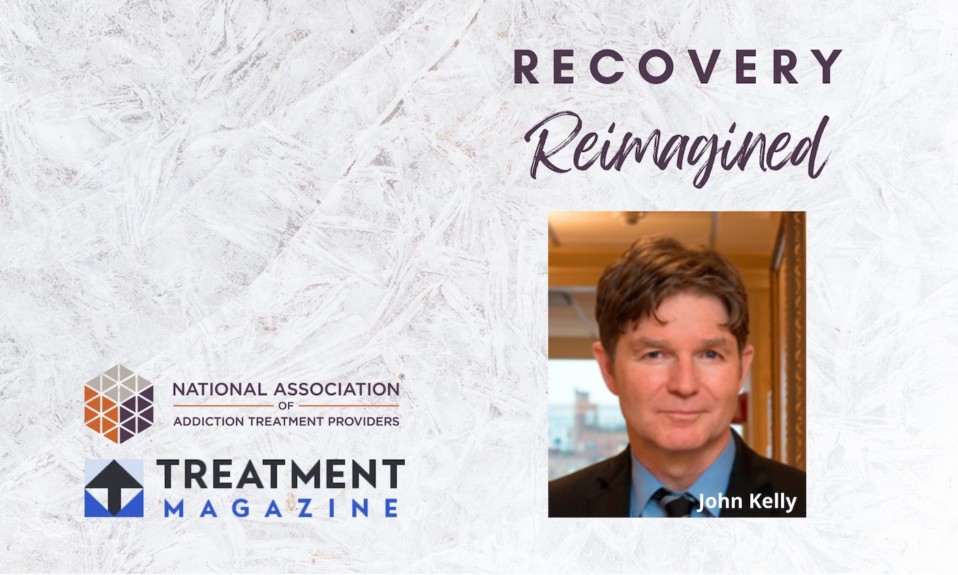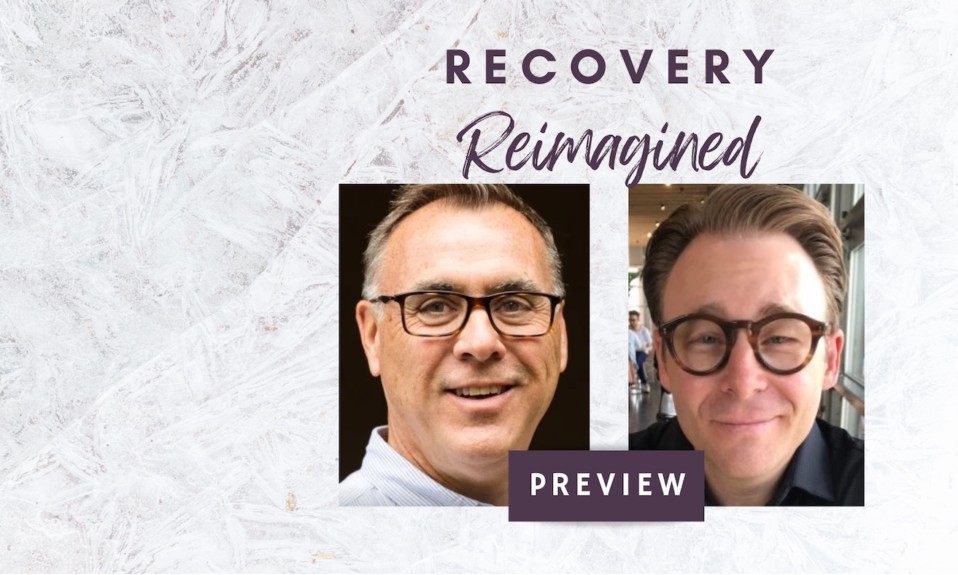In our first in a series of interviews, we sit down with one of the preeminent figures in the addiction treatment field
By Annie Peters, PhD, LP
Editor’s note: Welcome to Recovery Reimagined, a newly formed collaboration between the National Association of Addiction Treatment Providers (NAATP) and TreatmentMagazine.com whose mission is to analyze key issues in addiction treatment and, in turn, improve outcomes.
Recovery Reimagined will bring you interviews with the preeminent figures in the field, starting here with John Kelly, PhD, ABPP, a professor of psychiatry at Harvard Medical School. In addition to founding the Recovery Research Institute at Massachusetts General Hospital, Kelly has acted as a consultant to U.S. federal agencies, foreign governments and the United Nations about addiction medicine.
The interview with Kelly was conducted by Annie Peters, PhD, LP, an esteemed addiction treatment specialist in her own right. Peters currently serves as director of Research & Education for the NAATP. Part of her role involves developing the NAATP’s Foundation for Recovery Science and Education (FoRSE), which will provide much-needed standardized data for addiction treatment centers.
Kelly and Peters spoke scientist-to-scientist, and we think you’ll find their discussion to be edifying.
ANNIE PETERS: Thank you, Dr. Kelly, for joining me today. As I mentioned, this series is called Recovery Reimagined, so we can start there. What would you say needs to be reimagined in the field of addiction treatment and recovery?
JOHN KELLY: Well, it’s a big question, isn’t it? The first thing that comes to mind is greater connectivity between the different stakeholders, all trying to make a difference with these endemic problems related to alcohol and other drug use disorders. What I mean by that is, across these different constituencies and stakeholders—from criminal justice to treatment to medical care to SUD [substance use disorder] treatment to employers and educational systems—getting those people talking to one another. Oftentimes we are opposing forces trying to make a difference in society instead of all swimming in the same direction. We’re kind of swimming, sometimes against tides moving in the opposite direction, even though all of our intentions are good.
“We need to really be thinking better about connecting the dots in the communities in which people live to provide this continuous recovery support infrastructure and scaffolding. What we’re showing now is this does enhance the chances of remission and [produce a] shorter time to stable remission.”
—John Kelly
One of the other things, from the clinical and recovery support service perspective, is to connect the dots more with primary treatment for SUD continuing care and then recovery support services. We can make much stronger linkages back and forth when necessary between formal clinical treatment and then community-based services, so that we can provide a more cost-effective and efficient model of care that can hopefully enhance remission rates and shorten the time to remission and stable remission via connections to these recovery support services. What we are learning is that clinical professional treatment plays a vital role for many people in detoxification and stabilization, which is so critical—oftentimes life-saving.
But what do we do next, once we’ve provided those initial weeks or months of treatment, and usually more expensive treatment? How can we then build on that? I think that’s where we dropped the ball historically. We need to really be thinking better about connecting the dots in the communities in which people live to provide this continuous recovery support infrastructure and scaffolding. What we’re showing now is this does enhance the chances of remission and [produce a] shorter time to stable remission.
AP: It certainly makes sense with a chronic illness. We don’t want an acute care model with a short-term stay in treatment and then not connect the person to the resources in their communities. What would you say are some of the most promising changes you’ve seen in the last few years in the field?
JK: I think the growth of medications has been very critical and the greater adoption of empirically supported treatments, both medications and others. Also a greater movement toward integrating SUD screening and early intervention in medical settings. This is critical if we are going to really start to address these very high-volume, high-burden diseases more adeptly, more efficiently, as a society. We have to recognize that these are medical problems that deserve treatment and incorporation into medical infrastructures at large.
Alcohol accounts for 75% of all addiction cases in the United States. Many of those individuals are being seen by primary care and by mental health practitioners—behavioral health but not focused on addiction. It’s a great opportunity for screening, for detection, for beginning the conversation earlier in the course of these illnesses, so that we can actually make a bigger impact sooner. We often have waited for stage three, stage four addiction to come along, by which point people’s lives and their families are often devastated, if they’re still alive. We can do a much better job, and a more effective and efficient job, sooner, if we would incorporate many of these practices.
AP: So to bring this into the field of healthcare, really make sure that we’re at least doing basic screening for substance use and substance-related behaviors and problems, everywhere.
JK: The nice thing about this is that there’s good data now to show that, just like other illnesses, the earlier you intervene, the shorter the time to remission. That’s good news all around.
“We often have waited for stage three, stage four addiction to come along, by which point people’s lives and their families are often devastated, if they’re still alive. We can do a much better job.”
—John Kelly
AP: What change in the healthcare system do you think would have the greatest impact on people getting well from SUDs?
JK: Well, my bias is on measurement and evaluation. This is one of the things that NAATP has done very well in the last few years—to really emphasize this aspect of evaluation and outcomes. You should be applauded for that, because it’s something that’s long overdue, something that we still need to do a much, much, much better job at. Not just in SUD care, but in mental health care and medicine broadly.
Oftentimes we make assumptions about effectiveness that are not really supported by data. We have efficacy trials, which are more rigorous, randomized controlled trials, but they don’t always translate well into the real world. Point-of-care measurement and evaluation of recovery vital signs are key to understanding the impact and cost-effectiveness of what we do. “If we don’t measure it, we can’t improve it,” as Lord Kelvin once said many years ago. If you can’t measure it, you can’t improve it; you don’t know what’s going on.
If you think about businesses, they talk about profits and sales and units sold, and they’ve got those metrics where they look at their impact and volume and so on. Our sales, if you will, is people in remission. How many people are we expanding access to treatment to, getting more people into treatment? Are we providing quality care that is impacting their life, and their families’ lives, and saving lives? My bias is doing a much better job—not tacking this on to a laundry list of things to improve treatment, but making this front and center, making measurement and evaluation a very important piece.
I always [use] this analogy: When we talk about treatment of other chronic illnesses like hypertension and diabetes, the first thing you do when you go to the doctor is they put a cuff on you and they take your blood pressure. That becomes the basis for care. Without that measurement, they don’t know what’s going on. We’ve done a poor job in the addiction field. We don’t have bio-markers per se like that. We do have urinalysis and can detect alcohol or other drug use. But we need other kinds of behavioral markers. They are usually self-reported measures which are validated that we can use as recovery vital signs to direct care.
AP: Can you talk a little bit about what those might be? I’ve heard you talk about recovery vital signs, and I think that would be useful.
JK: These are the intermediate targets, as well as the ultimate targets, of what we do in treatment. For example, if you are in an outpatient treatment, which is 80% of treatment for SUD in the country, it would be things like alcohol and other drug use, heavy use, use to intoxication, consequences, HIV, shared needle use, injection drug use, and mental health symptoms and functioning. Those dimensions are key targets in our treatment.
“I think we should stop thinking about it as research. Think hypertension, think diabetes. You always capture those metrics when people come in that drive care. We just need those metrics to drive addiction care—validated tools that can really help us.”
—John Kelly
We want to get people into remission, [but] how can we get there? You can look at these behavioral markers of substance use—intensity of use, intoxication, accidents, injuries, IV drug use, overdoses, arrests, employment. In the residential setting, it’s a little more tricky because you don’t have those primary outcomes—i.e., substance use and exposure, because people are in a protected setting or a controlled environment. You can get, of course, smuggled drugs and alcohol into these settings, but for the most part they’re controlled environments. So how would you measure improvement? What we do there is that you take indices; these are usually psychological indices which predict outcome [after leaving the] controlled environment. These would be things like people’s attitudes toward certain things like taking medications, toward mutual help involvement, toward continuing care. You could look at coping skills acquisition during treatment, self-efficacy, their confidence in their ability to cope with different high-risk situations on the other side of the controlled environment. Those are the kinds of intermediate targets which would need to be measured during treatment.
If they’re the right measures, we know they predict outcomes after they’re out of that controlled environment. We should see changes in those expected treatment targets once they’re made explicit. A lot of treatment providers don’t understand exactly what things to measure. This is a bit of a problem, but you can easily find out the targets that predict outcomes, which should show a change during those residential phases of care. So if they’re going up on those indices, you know there’s a very high likelihood that they’re going to be doing well after treatment.
AP: What are the steps that would get us to where we need to be with measurement? Or what do you think is preventing our progress; what are the roadblocks?
JK: I think part of it is cultural. We have not really paid attention to measurement and evaluation. We’re just not used to that. As a clinician myself, I understand that. When I first started in the clinical field, I wasn’t thinking I had to measure things—I wanted to help people get well. This is where our heart is, why a lot of us get involved in the care of people with addiction. We want to make a difference. We want to help people feel better and do better and suffer less. What I realized, and I think many people do, is that there is great power in the ability to measure our outcomes and response to care. They do it in medicine, as I mentioned in hypertension, diabetes [and] other aspects of chronic illness management, which then provide the basis that drives care. You can clearly look at outcomes and the ability of different treatments to produce good outcomes.
There’s a cultural shift which is going on right now, where we need to think more squarely about how we can teach our trainees in our schools, undergraduate and graduate professional training programs to understand the significance of these things. We spend a massive amount of our GDP on healthcare, and largely we don’t know how effective it is. Broadly speaking. I think it’s even worse in so-called behavioral health care. Therefore, we cannot improve. I don’t know if you ask your treatment agencies, “Are you improving on your outcomes year over year? Are you learning from your own clientele about who’s not responding to the treatment delivery? Who’s falling through the cracks, who’s pulling down your average outcome rates?” Most of them would say, “No, I don’t know,” if they’re honest. “Are you improving year over year on retention, engagement and improving quality of care and outcomes?” Most people don’t know the answer to that.
We are funneling billions of dollars into this, with no idea if we’re actually improving on the outcomes of patients that are desperately seeking our help. Really paying attention to this, not as number seven in the list of things that need to be done—but number one. We’re throwing good money after bad over and over again without any real gain in the quality of care. There’s an opportunity here to really be a game-changer, a paradigm shift, in improving the quality of care for desperate families and people who suffer from SUD.
AP: Thank you so much. That’s exactly what NAATP is working on right now, as I know you are from the research perspective. We try to support our providers in exactly what you said, trying to build a culture of measurement.
JK: I think we should stop thinking about it as research. Think hypertension, think diabetes. You always capture those metrics when people come in that drive care. We just need those metrics to drive addiction care—validated tools that can really help us. Then we’ve got those to stand on. If they’re validated metrics, we know we can stand on those and show our outcomes in terms of the benefits that people get from treatment.














